Back pain in cheerleaders is often the result of repetitive movements rather than a one-time event. Overuse injuries in the back are often due to repeated extension required by backbends, tumbling, and stunting in cheerleading. Many cheerleaders exhibit similar patterns of muscle imbalances, including tight hip flexors, weak lower core muscles and glutes, and excessively flexible hamstring muscles. These imbalances can cause the athlete to stand in an extended low back posture (sway back) during the day and during sport. This posture can place increased strain on the muscles, ligaments, and joints of the spine. In addition, limitations in the shoulders can play a role in how cheerleaders perform their skills.
How Can Shoulders Affect the Low Back?
Lack of Shoulder Flexibility
- Lack of overhead shoulder flexibility can lead to compensations by arching more in the low back to get shoulders “further back”
- Cheerleaders may use more lumbar extension rather than shoulder range of motion to achieve positions for tumbling and stunting if their shoulders are tight
- Areas that may be tight include the pectorals, thoracic spine, and the latissimus dorsi
Lack of Shoulder Strength
- Weakness in the shoulders can affect the transfer of force throughout the body when performing tumbling or stunting
- Muscles that may be weak include the rotator cuff muscles and the muscles surrounding the shoulder blade
How to Improve Shoulder Flexibility
Foam Roll Thoracic Spine
- Start with the foam roller on the middle of your back, and work your way up towards your upper back, performing a few extensions every few inches as you move up. You can have your arms crossed over your chest or behind your head. Avoid arching your low back by keeping your bottom on the ground.
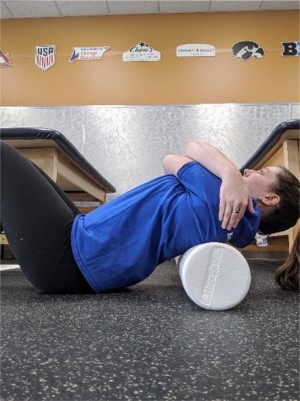
Foam Roll Shoulder Stretch
- Perform shoulder stretch with a foam roller, focusing on stretching shoulders and upper back. Lie on your stomach with your arms overhead-place the foam roller under your wrists. Avoid arching your lower back and focus on the shoulders and upper back. If the foam roller is too large to start, use a 1-panel mat instead.
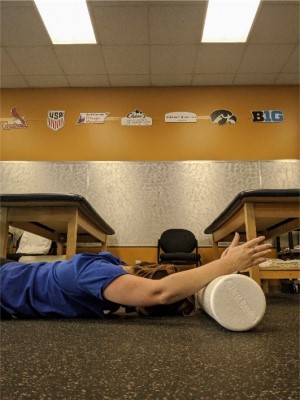
Foam Roll Pec Stretch
- Lying on a foam roller with a roller parallel to your spine allows your arms to relax out to the side. You can bring your arms up higher or bend your elbows as if in a goal post until a stretch is felt across the front of your chest. Hold for 20 seconds.
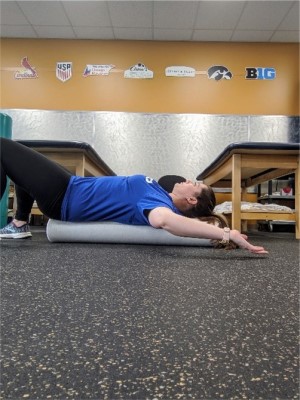
Exercises to Improve Shoulder Strength
Diagonal Theraband Exercises
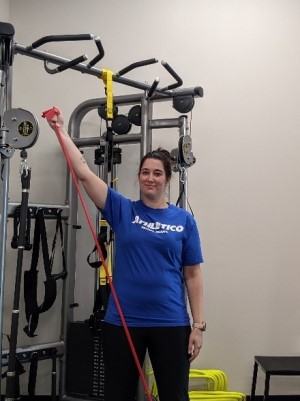
- If theraband is long enough, stand on one end and use the opposite arm to perform diagonal reach up to overhead. You can also hold an opposite hand down by your side. Perform 3 sets of 10 reps on both sides.
Shoulder Rows With Theraband
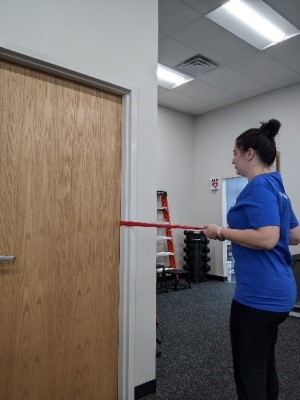
- Tie theraband in a knot and place the knot in the door by hinges and close the door. Using the two ends, perform a row and squeeze between the shoulder blades, do not shrug the shoulders. Perform 3 sets of 10 reps; go slow and controlled.
Shoulder External Rotation with Theraband
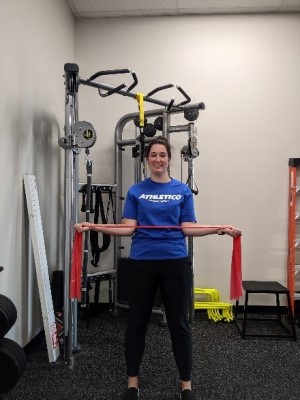
- Holding theraband in both hands, with elbows bent. Keeping elbows by your side, rotate your hands simultaneously to the side, squeezing the shoulder blades together. Perform 3 sets of 10 reps.
Overhead Press with Medicine Ball at A Wall
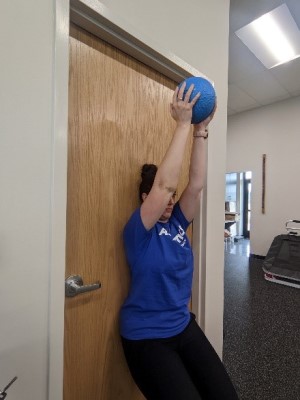
- This is a good exercise for bases. Stand with your back against the wall and walk your feet forward as far as you need to ensure the low back is flat on the wall. Raise a medicine ball overhead while keeping the low back flat on the wall. Perform 2-3 sets of 10 reps.
Planks/Push Up +
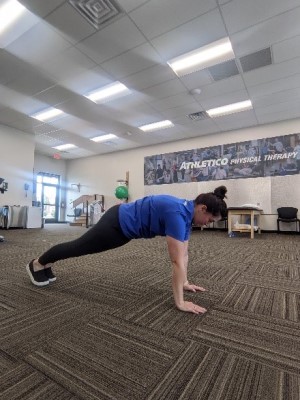
- Make sure the hands are right under the shoulders and push down into the floor as if pushing yourself away from the floor to activate the muscle near the shoulder blade that wraps around the rib cage. You can also perform on the wall to make this a little easier and progress down to the floor into a full push-up position. Hold for 30 seconds.
Wall Clock with Theraband
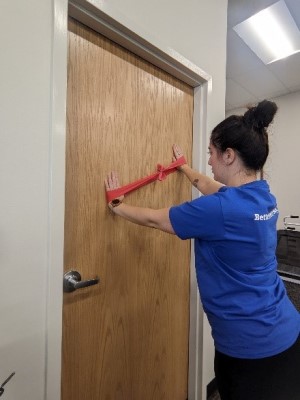
- Wrap theraband around hands/wrists and place hands flat on the wall.
Reach up at a diagonal with one hand, then return to the middle, out to the side, and down at a diagonal. Repeat on both hands. Move feet away from the wall to be in more of a push-up position to add difficulty. Perform 10 times on both sides.
If you are experiencing any pain, do not hesitate to find your closest Athletico to schedule a free assessment. Free Assessments are available in-clinic and virtually through our Telehealth platform.
*Per federal guidelines, beneficiaries of plans such as Medicare, Medicaid, Tricare, VHA and other federally funded plans are not eligible for free assessments.
The Athletico blog is an educational resource written by Athletico employees. Athletico bloggers are licensed professionals who abide by the code of ethics outlined by their respective professional associations. The content published in this blog is for informational purposes only, does not constitute medical advice and should not be relied on for making personal health decisions.
About the Author:
Tara Hackney, a physical therapist in Marion, IA, enjoys working with all patient types, especially gymnasts, cheerleaders, and dancers. She is the prominent blogger for Athletico's Gymnastic/Cheer Program. With an orthopedic specialization and training in dry needling and Graston technique, Tara hopes to answer your questions about injuries and injury prevention in an easy-to-understand manner. She hopes to ease fears surrounding pain and injuries, address concerns about recovery, and provide tips to prevent injury. In her free time, she enjoys spending time with her dog, reading, and watching her nephews play sports.

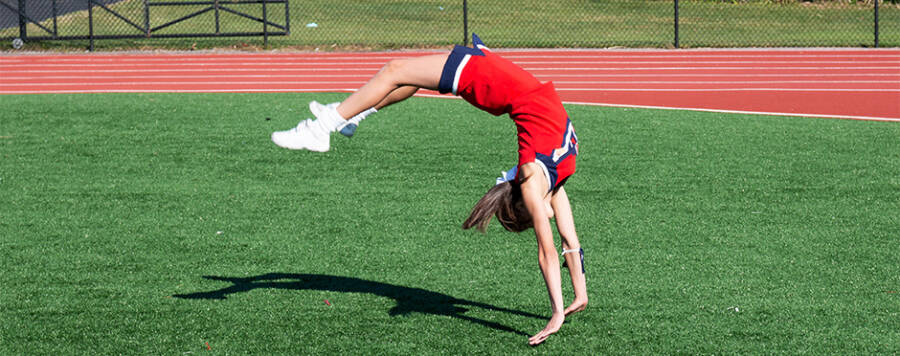 width="900"
height="356"
>
width="900"
height="356"
>
